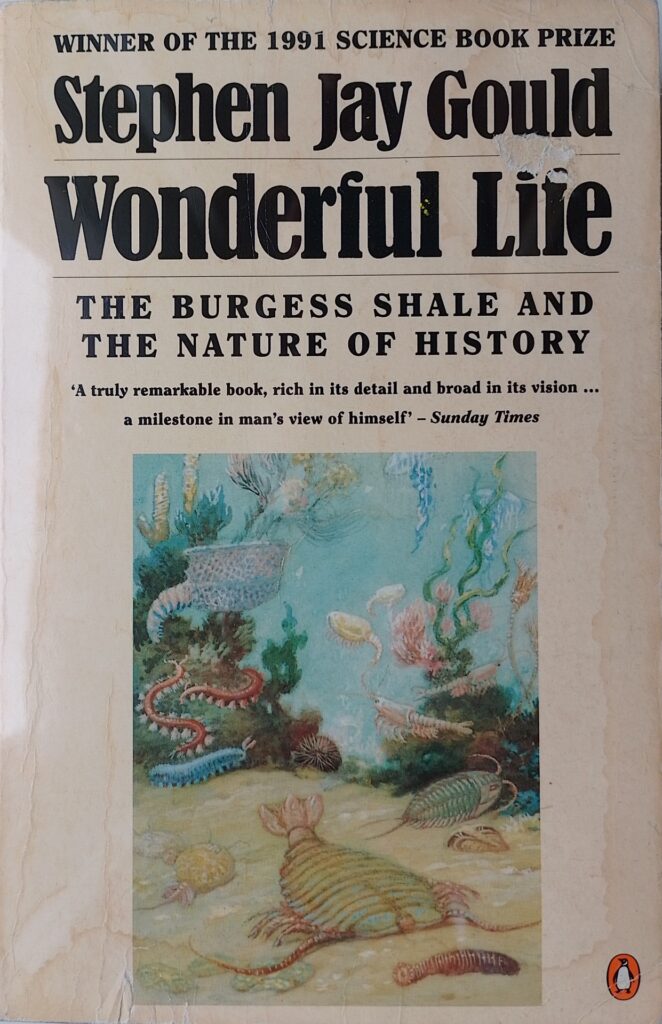First published 1989. Penguin paperback, 1991, pp 347, c. 115,000 words (main text) + .
Gould was a paleontologist at Harvard University and a science communicator. This work summarises his interpretation of the results of other’s research on the organisms whose remains were found in the Burgess Shale, which lies in the Rocky Mountains of British Columbia, Canada. This shale had been laid down shortly after the Cambrian Explosion, a sudden flowering of life that started some 570 million years ago. The book is very accessibly written by a professor of paleontology: someone who was known for his ability to communicate science to a non-specialist audience. Not that Gould shies away from the details: there are many descriptions, drawings and photographs of the soft-bodied animals whose remains were captured when a muddy cliff suddenly fell on them. He also gives considerable detail on the people who found and interpreted these creatures, colouring in the social, political and personal background of some of the principles, which may have influenced how they presented their findings.
Gould’s thesis is that the Cambrian explosion produced a huge range of creatures with widely different body forms, and most of these subsequently perished, leaving a relatively small number of types of creature, each of which later evolved into all the species we know today. Gould believed that this selection was contingent on external factors, and not on how well adapted to the environment in which they lived. It was a matter of luck which survived and which did not. There was no inevitability about our eventual existence.
The early major work of collecting and classifying the creatures was done by an eminent American, Charles Walcott, between 1909 and 1917. He classified all the creatures into the known phyla that continue to this day. Gould asserts that this is a reflection of Walcott’s conservative views about the steady march of progress, and ultimately the inevitable ascendency of humans.
Walcott was a very busy administrator, running the Smithsonian Museum as well as chairing other august scientific bodies. He also managed to continue to publish scientific papers but never revisited his initial interpretation of the Burgess fossils. That work was taken up by Harry Whittington and others who re-examined the Burgess shale in 1966 and later, and also restudied the vast collection made by Walcott, stored in the Smithsonian in Washington. Whittington and his colleagues spent a lot more time than Walcott had studying the fossils, including painstakingly scraping away layers to reveal the three-dimensional form of the creatures. Their findings suggested to many that the fossils needed to be reclassified. Some clearly did fit into the existing phyla, but some did not and might be best placed in previously unknown phyla that did not survive through to the present day.
The major problem for palaeontologists is that there is no complete record of the history of life on earth. All we are left with is a random collection of fossil-bed snap-shots, often widely separated in time, as well as geography. This leaves the field wide open to interpretation, and there seem to be as many theories on the origin and development of life as there are palaeontologists. Gould proposed a theory call ‘punctuated equilibrium’ where evolution was given a sudden boost by some external factor and then settled down to an almost steady-state where creatures evolved very slowly, if at all. During the ‘boost’ phase, the rapid evolution resulted in a huge diverse range of creatures, most of which ultimately failed to survive. The boost might be caused by some major change in conditions on the surface of the planet, such as a sudden change that resulted in the demise of the previous forms of life or opened an opportunity for new forms to take over.
As a non-expert, it seems to make sense that evolution is not a steady process, but is a response to the environment, which includes not only the physical but also the ecological. Gould seems to think this is a huge deal, and a battle between conservatives (e.g. Walcott) and liberals (e.g. himself). All science, like every other human endeavour, is conducted in a political environment, but it seems unhelpful to push a scientific debate into a political-ideological battle. Perhaps like economics, palaeontology is hampered by the paucity of evidence, complexity of that that dose exist, inability to run isolated experiments, and to rerun the tape of life with slightly different starting conditions to see how the outcome differs from that observed in the real world. These matters then become a question of interpretation, and we are all political animals, subject to the times in which we each live. Indeed, many of the fossils have been re-examined, after this book was written, and placed in existing phyla, closer to Walcott’s interpretation.
This is highly readable, despite the detail in to which it delves. The language is clear and mostly (but not completely) jargon free. Some of the detail may be excessive, but that has its own fascination. Gould makes a strong case for his thesis, although it’s tainted with his own politics. Be amazed at the detailed work put in by many in examining and reconstructing the, often weird, creatures of the Burgess Shale.
Wikipedia biography of Gould: https://en.wikipedia.org/wiki/Stephen_Jay_Gould
Wikipedia summary of the book: https://en.wikipedia.org/wiki/Wonderful_Life_(book)
Others’ reviews of the book: https://www.goodreads.com/book/show/36475.Wonderful_Life?from_search=true&from_srp=true&qid=aPt0bn4aDl&rank=2
© William John Graham, December 2023

